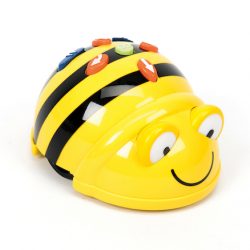Tried and Tested Alternatives To Consider
By liaising with the subject/class teacher it should be possible to identify the learning objectives that cannot be accessed in the mainstream lesson and agree alternative, accessible ways to present that learning.
Coding
- A hands-on approach
Practical alternatives include Bee Bot and Code jumper. These consist of practical objects that can be given instructions via buttons and switches (inputting code); they will then carry out the instructions (run the programme) which can give an audible output or result in the object moving; the programme can be evaluated and then corrected (debugging) or improved.

- Text based programming
Computer programs in the real world are often produced simply by writing text which is very accessible. Software that allows users to drag and drop chunks of code that have already been written is useful in an educational context as it can produce impressive results with only a basic grasp of a few concepts but it is not essential to be able to use this type of software to code.
Text based coding solutions include BASIC with the Chipmunk editor and python with the Notepad++ editor. Python is a particularly useful language to use with pupils who might potentially study computing at GCSE as it is the only language accepted by all of the three major exam boards in England. - Alternative educational software
One example is Swift Playgrounds: a free, fun software package from Apple that teaches coding concepts. It runs on the iPad and is accessible using the in-built accessibility features (such as larger text, zoom and Voiceover).

Web design
As for coding, software is available to make web design quick and easy without having to understand any of the concepts behind it. However, the knowledge and skills for designing web pages can be learned through writing text. No special software is needed just a text editor to write the html code in (Notepad which comes with all Windows computers is ideal or Textedit on a Mac) and any standard browser.
Download – HTML – writing web pages
Flow charts
Schools often use software to teach flow charts. If this is inaccessible, a low-tech alternative with cut-out shapes which the pupils can arrange and then label is a simple alternative.
Control systems
Instead of teaching control systems using modelling software, a hands-on approach can be used. A good example is the very accessible MFA (Microelectronics For All) kits and activities: the pupil builds their control system by connecting physical components on a board with wires and then tests it out to see if it works.
Other resources
Detective Dot is a book based resource aimed at KS2. Many themes in the computing curriculum are addressed through an adventure story available as a paperback and eBook.

Interactive fiction (IF). Based on ‘choose your own adventure’ stories, IF can be used to illustrate some concepts of coding. Choice of Games have a range of accessible interactive fiction apps for mobile devices (for age 12+; some stories are free or have free initial chapters). Software is available to create IF but is more suitable for staff with a background in computing or hobbyists.
Also in this resource:
Quick guide to choosing a strategy – PDF download
